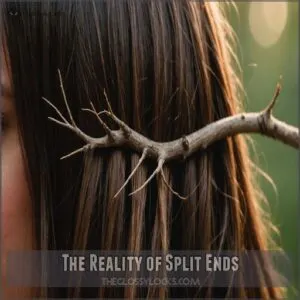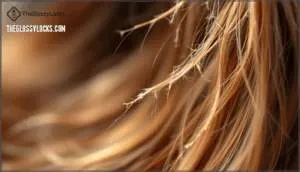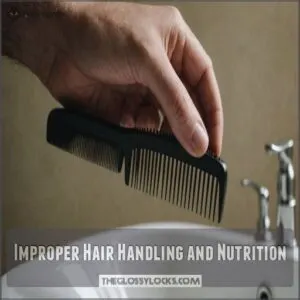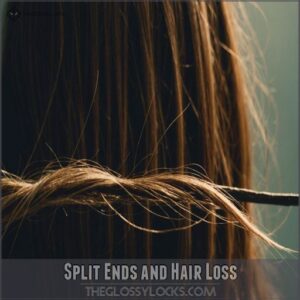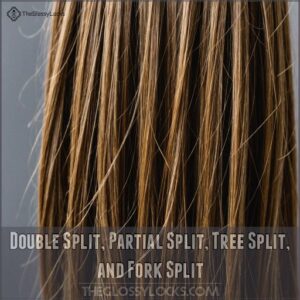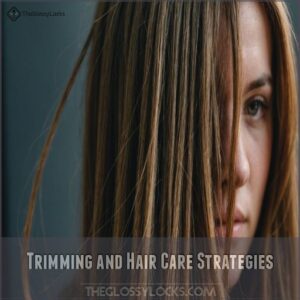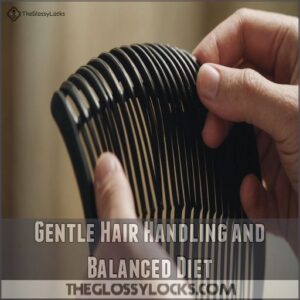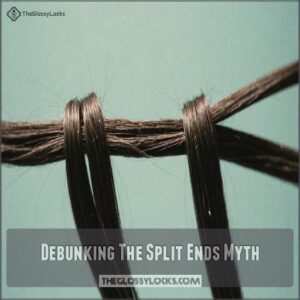This site is supported by our readers. We may earn a commission, at no cost to you, if you purchase through links.
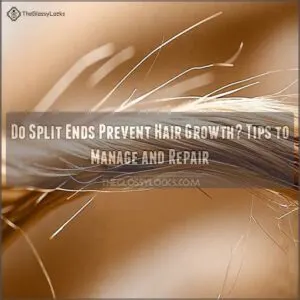
They won’t halt progress, but they can cause your hair to break more easily, making it seem like it’s not gaining length. Regular trims and gentle care can help manage split ends and keep you in control of your hair destiny.
Curious about managing those pesky split ends without breaking a sweat? Stick around for tips that might surprise you!
Table Of Contents
- Key Takeaways
- The Reality of Split Ends
- Causes and Effects of Split Ends
- Split Ends and Hair Loss
- Types and Prevention of Split Ends
- Treatment Options for Split Ends
- Managing Long Hair With Split Ends
- Debunking The Split Ends Myth
- Frequently Asked Questions (FAQs)
- Will split ends stop hair growth?
- What are the treatment options for split-ends in the hair?
- Do Split Ends make your hair look shorter?
- Why do some hair types have split ends?
- Does split hair cause hair growth?
- Is split hair more prone to breakage and Split Ends?
- What happens if you don’t cut split ends?
- Can split ends cause hair thinning?
- Does cutting ends help hair grow?
- Is it bad to pick split ends?
- Can I prevent split ends completely?
- Do certain hair types get split ends more?
- How often should I trim my split ends?
- Are split ends a sign of unhealthy hair?
- Do hair masks help with split ends?
- Conclusion
Key Takeaways
- You might think split ends stop hair growth, but they don’t; they can lead to breakage, making hair appear shorter.
- Regular trims help manage split ends and reduce breakage, giving the appearance of healthier, longer hair.
- Avoiding heat styling and using gentle products can decrease the risk of developing split ends.
- Maintaining a balanced diet supports scalp health and can contribute to stronger hair that resists damage.
The Reality of Split Ends
Ever wonder if those pesky split ends are really stopping your hair from growing?
The truth is, while they don’t halt growth at the root, they can lead to breakage, making it seem like your hair’s stuck in a growth rut.
Hair Growth and Split Ends
Ever wonder why split ends seem to ruin your day? These pesky culprits emerge from hair damage, age, and the environment.
Though they don’t stop hair growth directly, they can make gaining visible length a challenge.
You can find some helpful tips for preventing further damage and maintaining a healthy scalp, such as exploring home remedies for toothache pain relief, in the Health & Wellness section.
To raise your hair game:
- Trim regularly
- Moisturize often
- Use gentle products
- Avoid excess heat styling
- Protect against environmental damage
Keep it healthy, keep it happy!
The Role of Split Ends in Hair Breakage
Imagine this: split ends can cause hair breakage, putting your hair’s length dreams on hold.
When those pesky end splits meet friction from brushing or environmental factors, breakage happens.
It’s like your hair’s way of saying, “I’m not there yet!”
Adopting better hair care habits can tame this beast.
So, trim regularly and dodge harsh treatments to keep hair growth on track.
Causes and Effects of Split Ends
So, what exactly causes those pesky split ends?
It’s usually a combination of things like heat styling, harsh chemicals, and even just rough handling—think of it as your hair’s version of a bad day!
These damaged ends don’t stop hair growth itself, but they do make your hair more prone to breakage, meaning you mightn’t see as much length as you’d like.
Environmental Factors
Walking outside on a windy day is like giving your hair a free rollercoaster ride—fun but damaging.
Sun exposure, pollution, and dry air are the main culprits causing split ends, which can be exacerbated by constant heat from styling tools, chemical treatments, and physical damage, as seen in common hair care mistakes.
These environmental factors weaken hair, leading to hair damage and breakage over time.
Don’t stress too much, though! With proper hair care, you can combat these effects and maintain healthy hair growth.
Heat Styling and Chemical Treatments
Imagine wanting sleek, shiny hair but feeling puzzled by split ends.
Heat styling damage and chemical treatments are major culprits here.
They weaken your hair’s structure, leading to breakage and stunting visible hair growth.
To minimize heat damage from styling tools, apply a heat protectant before use to shield your hair from thermal damage and nourish with vitamins and oils, as discussed in heat protectant tips. To sidestep this, explore heat styling alternatives and check hair product safety.
Balancing your style aspirations with hair health isn’t just smart—it’s essential!
Improper Hair Handling and Nutrition
Now that you’ve realized heat styling’s impact, consider how your hair handling and nutrition matter too.
Yanking a comb through wet knots damages more than you think.
Skip harsh products, and let your hair breathe.
Also, junk food binges don’t help hair growth.
A balanced diet boosts scalp health, tackling split ends, hair damage, and bringing back that healthy shine.
Split Ends and Hair Loss
You might worry that those pesky split ends are causing your hair to fall out, but the reality is a bit less dramatic.
Split ends give your hair a scraggly look and can lead to breakage, but they don’t actually cause hair loss.
Clarifying The Relationship
Split ends and hair loss are often lumped together, but they’re not.
Think of split ends as those pesky snags that mess with hair length, not actual culprits of hair loss.
Your hair grows from the scalp, irrespective of its split end situation.
While splits don’t cause shedding, they can stunt visible growth because of breakage.
So, trim regularly for better hair health and growth.
Hair Follicle Vs Hair Shaft Damage
You might wonder if split ends wreak havoc on your hair’s growth.
While split ends target the hair shaft, causing breakage, your hair follicle remains untouched, continuing its growth cycle unhindered.
Think of it like a tree losing some leaves but still growing tall.
Keep a healthy hair care routine to protect the shaft and let those follicles do their magic, ensuring luscious locks.
Types and Prevention of Split Ends
Let’s explore the different types of split ends—from the common double split to the more dramatic tree split—so you can better understand what’s happening to your hair.
Split ends are a common hair problem, and they can happen to anyone.
Then, we’ll cover simple prevention strategies, like gentle handling and regular trims, to keep those pesky split ends at bay and your hair looking its best.
Double Split, Partial Split, Tree Split, and Fork Split
Recognizing split ends can save your hair from further damage.
From the double split that resembles a fork in the road to the tree split’s branching chaos, each type signals weakening hair shafts.
These splits don’t cause hair loss but can make growth seem stagnant.
By learning to identify these culprits, you empower yourself to prevent hair breakage effectively.
Trimming and Hair Care Strategies
Think of your hair as a valuable garden requiring regular upkeep.
Trimming frequency matters, so consider a hair trim every six to eight weeks to keep hair and split ends in check.
Choose a good hair brush wisely; flexible or cushioned options help.
Use products designed for strength, and explore at-home treatments for a boost in hair growth and care.
Gentle Hair Handling and Balanced Diet
Ever notice how your hair thrives with a little tender loving care?
Gentle handling and a balanced diet can work wonders for hair growth and split ends prevention.
This is especially important since common causes of split ends like excessive heat styling and chemical treatments can weaken hair structure.
Try these:
- Use a wide-tooth comb to minimize breakage.
- Incorporate vitamins like biotin and omega-3 for scalp health.
- Handle wet hair gently to avoid damage.
Practical tips lead to hair care success!
Treatment Options for Split Ends
You’ve battled split ends long enough, so let’s talk about what really works to rescue those frazzled tips.
From soothing nourishing oils to professional keratin treatments, you’ll find solutions that repair damage and leave your hair looking like it just stepped out of a salon commercial.
Nourishing Oils and Professional Hair Treatments
Imagine letting your hair sip on nourishing oils; they’re like a spa day for your strands.
Oils, from coconut to argan, bring benefits that make your split ends sigh with relief.
However, certain oils and creams can only temporarily glue split ends together, as split end prevention techniques suggest that a long-term repair isn’t possible without snipping them.
Pair these with salon treatments for hair repair, like masks, and you’ll nurture growth while managing breakage.
Home remedies also help.
Here’s a handy table:
| Oil Types | Salon Treatments | Home Remedies |
|---|---|---|
| Coconut Oil | Deep Conditioning | Hot Oil |
| Argan Oil | Hair Masks | Olive Oil |
| Jojoba Oil | Scalp Treatments | Aloe Vera |
| Avocado Oil | Steam Therapy | Honey Masks |
| Almond Oil | Trim Technique | Egg Yokes |
Keratin Treatment and Gentle Hair Products
After nourishing oils, consider keratin treatments and gentle hair products for managing split ends.
Keratin treatment benefits include reducing frizz and adding shine, though the cost can be steep.
You might try DIY keratin masks for a budget-friendly option.
For those seeking a more professional treatment, explore products offered with a keratin hair treatment kit Professional Keratin Treatments.
- Check out gentle product brands that nurture hair without harsh chemicals.
- Focus on long-term maintenance to prevent hair damage.
- Enjoy healthier hair growth with these strategies!
Managing Long Hair With Split Ends
Managing long hair with split ends can feel like a constant battle, but don’t worry, it’s totally manageable!
Regular trims, gentle handling, and the right products are your secret weapons for keeping those luscious locks healthy and growing strong.
Prevention Strategies and Trimming Techniques
To keep split ends at bay, try regular trimming.
Use split end tools for precise home trimming, ensuring your hair stays healthy and grows.
Detangle gently with a wide-tooth comb to reduce breakage.
A consistent hair care routine is key—treat your hair like a prized possession and watch it thrive.
Here’s a quick tip table for you:
| Tip | Benefit |
|---|---|
| Trim regularly | Prevents breakage |
| Use right tools | Precision cutting |
| Detangle gently | Less breakage |
| Hair care routine | Overall health |
Maintaining Healthy Hair After Treatment
You’ve snipped those split ends, now let’s focus on maintaining your long, luscious locks.
Keeping hair healthy post-treatment involves a few simple steps.
First, use quality hair products to strengthen and protect.
Second, visit your salon regularly to prevent further damage.
Finally, embrace a balanced diet rich in nutrients to support growth.
With these tips, your hair will shine and grow beautifully.
Debunking The Split Ends Myth
You might’ve heard that split ends stop your hair from growing, but that’s just a hairy tale.
While split ends can make your hair look shorter by causing breakage, they don’t actually send a memo to your hair follicles to halt growth.
Separating Fact From Fiction
Contrary to popular hair growth myths, split ends don’t stop your hair from growing.
It’s time to separate fact from fiction.
Your hair follicle, the mastermind behind growth, doesn’t chat with those pesky split ends.
You can find a range of products for split end treatment that help manage and repair damage.
They cause breakage, though—ever notice strands falling short of your growth goals?
Regular trims keep them in check, letting you enjoy healthier hair habits and more length over time.
The Truth About Split Ends and Hair Growth
Worrying about split ends stopping your hair growth? They mightn’t be the villains you think.
Split ends impact hair health but don’t halt growth; they cause pesky breakage, hindering visible length.
Your hair grows from the scalp, not the ends.
To manage, trim split ends and adopt good hair care habits—think of them as routine maintenance for a smoother journey to healthy hair growth.
Frequently Asked Questions (FAQs)
Will split ends stop hair growth?
Split ends don’t halt hair growth; they cause breakage, making hair seem like it’s stuck in time.
Hair keeps growing from the scalp, but trimming split ends helps prevent breakage, giving you healthier, visibly longer hair.
What are the treatment options for split-ends in the hair?
To treat split ends, trim them regularly.
Use nourishing conditioners.
Avoid excessive heat styling.
Opt for gentle brushing.
Protect your hair with serums.
It’s like giving your hair a spa day minus the pricetag!
Do Split Ends make your hair look shorter?
When you have split ends, your hair might look shorter because those pesky splits lead to breakage.
So, instead of reaching its full length, your hair can fracture and leave you with less visible length.
Trim regularly!
Why do some hair types have split ends?
Hair types prone to dryness, like curly or coarse hair, often get split ends due to their structure.
These hair types struggle with moisture retention, leading to brittleness.
Factors like heat, chemicals, and handling can worsen split ends.
Does split hair cause hair growth?
Imagine discovering the secret of hair growth, and you’d find it’s not split hair holding you back.
Split ends don’t stop growth from the scalp, but they can cause breakage, leading to less visible length.
Is split hair more prone to breakage and Split Ends?
Split ends make hair more breakage-prone because the weakened structure snaps easily.
Split ends like tiny traitors in your hairline defense help avoid damage, keeping your strands strong and full of personality.
Trim regularly for healthy hair.
What happens if you don’t cut split ends?
They don’t stop your hair from growing, but they’ll travel upwards, causing breakage.
Think of it like this: untrimmed split ends mean more frustrating breakage, not less hair growth.
Regular trims are your friend!
Can split ends cause hair thinning?
You may notice that split ends can make your hair appear thinner, but they don’t directly cause hair thinning.
Breakage from split ends can lead to a less full appearance, though.
Does cutting ends help hair grow?
Think of trimming hair as weeding a garden.
It doesn’t speed up growth, but cutting damaged ends reduces breakage, making hair appear healthier and longer.
Regular trims are like maintenance, helping you achieve that flourishing look.
Is it bad to pick split ends?
Picking split ends might feel satisfying, but it can cause more damage by making splits worse.
Instead of snapping them off, trim them with scissors to avoid further breakage.
You’ll keep your hair healthier and happier.
Can I prevent split ends completely?
Completely preventing split ends is tough, but you can reduce them by avoiding heat styling, using conditioner, and getting regular trims.
Think of it like maintenance for your hair—a little care goes a long way!
Do certain hair types get split ends more?
Imagine hair like ancient, battle-worn warriors; different types face split ends uniquely.
Curly hair can be more prone due to its natural dryness and twists.
However, fine or chemically treated hair also tends to see split ends.
How often should I trim my split ends?
You should trim your split ends every 6-8 weeks. Using a hair breakage mask can help strengthen your hair strands, reducing the need for repairs. This prevents breakage and keeps your hair looking healthy. Don’t worry, it’s a quick fix for a big hair improvement!
Are split ends a sign of unhealthy hair?
Split ends can indicate unhealthy hair because they result from damage like heat styling or harsh chemicals.
They don’t affect new growth but can cause breakage and make hair look less healthy.
Regular trims help manage them.
Do hair masks help with split ends?
Think of hair masks as soothing balms for stressed-out strands.
While they can’t magically heal split ends, they hydrate and strengthen hair, reducing future breakage and giving your locks a healthier look and feel.
Conclusion
Surprisingly, over 50% of adults struggle with split ends that can lead to breakage if not managed properly, as regular trims help prevent split ends from working their way up, but don’t sweat it—split ends don’t prevent hair growth.
While they won’t stop your hair from sprouting at the root, they can make it seem stagnant by causing breakage.
Regular trims and gentle care are your best arsenal against these pesky splits.
Think of it this way: treating your tips with love helps maintain healthy, luscious locks, ensuring your hair grows long and strong.

